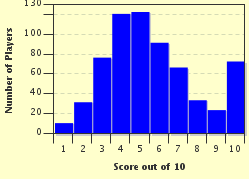Quiz Answer Key and Fun Facts
1. In addition to a cat's nose, it has a second scent organ called Jacobson's organ. How do cats use this organ?
2. What color eyes are all kittens born with?
3. All cats have whiskers.
4. Cats do not chew their food.
5. What area of a cat's brain controls balance, posture and movement?
6. If a cat's ears are flattened against its head, what emotion is it showing?
7. Do cats have collarbones?
8. Cats can survive without eating meat.
9. How do cats keep their hind claws maintained?
10. What does a cat use its tail for?
Source: Author
debbitts
This quiz was reviewed by FunTrivia editor
crisw before going online.
Any errors found in FunTrivia content are routinely corrected through our feedback system.

